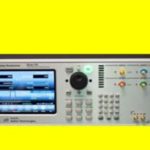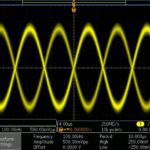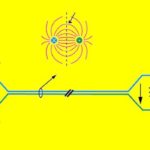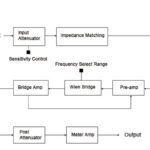It has often been the case that optimizing scope setting to display a detailed view of an FFT results in a time-domain view that is suboptimal. Not anymore.
Gary Waldo, Tektronix
The debugging of embedded systems often involves looking for clues that are hard to discover when examined one domain at a time. The ability to look at time and frequency domains simultaneously can offer important insights. Mixed domain analysis is especially useful for answering questions such as:
What’s going on with my power rail voltage when I’m transmitting wireless data?
Where are the emissions coming from every time I access memory?
How long does it take my PLL to stabilize after power-on?
Mixed-domain analysis can help answer questions like these by providing views of time-domain waveforms and frequency domain spectra in a synchronized view. Until now, the Tektronix MDO4000C mixed-domain oscilloscope has been the only scope to offer synchronized time and frequency domain analysis with independent control over waveform and spectrum views. It accomplishes this by incorporating a full spectrum analyzer with its own dedicated input channel.
There is a new approach that does not require a separate input channel but still provides similar time/frequency capabilities. It involves recently released firmware that unlocks an analysis tool called Spectrum View which takes advantage of patented hardware already in the instruments. With this tool, the scopes can provide simultaneous analog waveform views and spectral views, with independent controls in each domain.

For more complex troubleshooting, instruments with the upgraded firmware can perform mixed-domain analysis on more than one channel.
Although spectrum analyzers are designed specifically for viewing signals in the frequency domain, they are not always readily available. Scopes, on the other hand, are almost always handy in the lab, so engineers tend to rely on scopes as much as possible. For this reason, oscilloscopes have included math-based FFTs (fast Fourier transforms) for decades. And most modern scopes let operators look at amplitude-vs-time waveforms and amplitude-vs-frequency. So, what’s the big deal?

First, FFTs are notoriously difficult to use for two reasons. For frequency domain analysis, spectrum analyzer controls like center frequency, span and resolution bandwidth (RBW) make it easy to define the spectrum of interest. In most cases, however, oscilloscope FFTs only support traditional controls such as sample rate, record length and time/div, making it difficult get to the right view.

Second, FFTs are driven by the same acquisition system as for the analog time domain view. This means that speeding up the time scale in the time domain reduces resolution in the frequency domain. As a result, with conventional FFTs, it’s virtually impossible to get optimized views in both domains.
In contrast, Spectrum View provides the ability to adjust the frequency domain using familiar center frequency, span and RBW controls. And because these controls do not interact with the time domain scaling, it is possible to optimize both views independently.

On-screen indicators (spectrum time) show the source of the spectrum on the waveforms. The ability to synchronize the two domains is useful for correlating signal activity on a board with EMI emissions, for example.
Conventional FFT tradeoffs
The challenges with conventional FFTs go well beyond ease of use. To illustrate the performance tradeoffs engineers must consider, suppose we have a tone at 900 MHz and want to view its phase noise out to 50 kHz on either side with 100-Hz resolution. Ideally, the spectral view should be set to a center frequency of 900 MHz, a span of 100 kHz, and a resolution bandwidth of 100 Hz. With a traditional scope FFT, horizontal scale, sample rate and record length settings determine how the FFT works and must be considered holistically to produce the desired view.

Horizontal scale determines the total amount of time acquired. In the frequency domain, this determines resolution. The more time spent acquiring, the better the resolution in the frequency domain.
To resolve 100 Hz, we need to acquire at least (1/100 Hz) = 10 msec of time. However, in reality, we need to acquire nearly double that amount. In theory, FFTs are supposed to be applied to infinitely long signals. Because this isn’t possible, the beginning and end of the acquisitions introduce discontinuities (and thus error) into the resulting spectrum. To minimize discontinuities, the acquired record must fit in an FFT “window.” Most FFT windows have a bell or Gaussian shape where the tails are quite low and the center is high, meaning the spectrum must be primarily driven by the middle portion of the acquired data. Each window type has a constant associated with it. For this example, using a Blackman-Harris window type with a factor of 1.90 would require 19 msec (10 msec × 1.9 = 19 msec) of acquisition time.
Sample rate determines the maximum frequency in the spectrum, where Fmax = SR/2. For a 900 MHz signal, we need a sample rate of at least 1.8 GS/sec. Using the analog sampling on the 5 Series as an example, we would sample at 3.125 GS/sec (first available sample rate above 1.8 GS/sec).
Now we can determine the record length, L. This is simply L = Time Acquired × Sample Rate. In this case, L = 19 msec × 3.125 GS/sec = 59.375 Mpoints record length. Depending on the instrument, this record length may not even be available. Even if the scope has sufficient record length, many scopes limit the maximum length of an FFT because it is computationally intensive. For example, many previous-generation oscilloscopes have a maximum FFT length of approximately 2 Mpoints. Assuming you still want to see the 900 MHz signal (which requires the high sample rate), you’d have to acquire approximately 1/30th of the desired time resulting in 30 times worse resolution in the frequency domain.
As this example illustrates, setting up a desired view requires an appreciation of the complex interactions between horizontal scale, sample rate, and record length. Moreover, the reality of finite record length forces undesirable compromise. And observing high-frequency signals with good resolution in the frequency domain requires extremely long data records which are often unavailable, or expensive and time-consuming to process. Although some spectral analysis packages attempt to manage these tradeoffs, all oscilloscope FFTs to date face the limitations described above.
A new architecture
Providing a way to perform spectral analysis without running into the inherent tradeoffs of FFTs was a key design goal for Spectrum View. To understand how it works, note that digital oscilloscopes generally run their analog-to-digital converters (ADC) at the maximum sample rate. The stream of ADC samples goes to a decimator that keeps every Nth sample. At the fastest sweep speeds, all samples are kept. At slower sweep speeds, it’s assumed the user is looking at slower signals and a fraction of the ADC samples are kept. In short, the purpose of the decimator is to keep the record length as small as possible while still providing a sample rate adequate to view signals of interest in the time domain.

In the 5 and 6 Series MSOs, behind each FlexChannel input is a 12-bit ADC inside a custom ASIC called the TEK049. Each ADC sends high-speed digitized data down two paths. One path leads to hardware decimators which determine the rate at which time-domain samples are stored. The second path leads to digital down-converters (DDC) also implemented in hardware. This approach enables independent control of the time domain and frequency domain acquisitions, allowing optimization of both waveform and spectrum views of a given signal. It also makes much more efficient use of the long-but-finite record length available in these instruments.
To illustrate the process, consider the 900-MHz measurement scenario mentioned earlier but with the hardware digital downconverter added into the acquisition process. The total time acquired still determines the resolution in the frequency domain. We also still need to apply an FFT window and acquire data for 19 msec. In the TEK049, the ADC sends digitized time domain data to a decimator to create the time domain waveform view, but it also sends the data to the DDC.
As you might expect, the DDC has a profound effect on the required sample rate. The DDC shifts the center frequency of interest from 900 MHz to 0 Hz. Now the 100-kHz span goes from -50 kHz to 50 kHz. To adequately sample a 50 kHz signal, we only need a sample rate of 125 kS/sec. Notice that by inserting the DDC into the acquisition process, the sample rate required becomes a function of span, not center frequency.
Record length is governed by the same relationship as before. Record length is now 19 msec × 125 kS/sec = 2,375 points. The data is stored as in-phase and quadrature (I&Q) samples, and precise synchronization is maintained between the time domain data and the I&Q data. Remember, in the case of a conventional FFT the required record length was 59.375 Mpoints. The down-converted record only requires 2,375 points.
Now we perform an FFT on the 2,375-point I&Q record to get the desired spectrum. This dramatic reduction in the number of data points creates several important advantages:
First, it greatly improves the update rate. And much longer timespans can be processed, thus providing a spectrum analysis with much better frequency resolution. Moreover, the desired frequency domain view can be captured without changing the time domain view in any way
Toward more efficient system analysis
Efficient embedded system analysis and debugging begins and ends with insight. How can you possibly figure out why a system isn’t working as expected without precise, synchronized insight into both time and frequency domains? Clearly, you can’t, and engineers have long recognized this. But they have been constrained by limitations in conventional oscilloscope FFTs.
A new oscilloscope architecture enabled by new firmware points the way to a number of significant advances. It enables the use of familiar spectrum analysis controls (Center Frequency, Span and RBW). It allows optimization of both time domain and frequency domain displays independently. It also enables a signal to be viewed in both a waveform view and a spectrum view without splitting the signal path. Further, it enables accurate correlation of time-domain events and frequency domain measurements (and vice versa) and significantly improves the frequency resolution possible in the frequency domain. Last but not least, it improves the update rate of the spectrum display





thank you testandmeasurementtips for giving me wonderful information